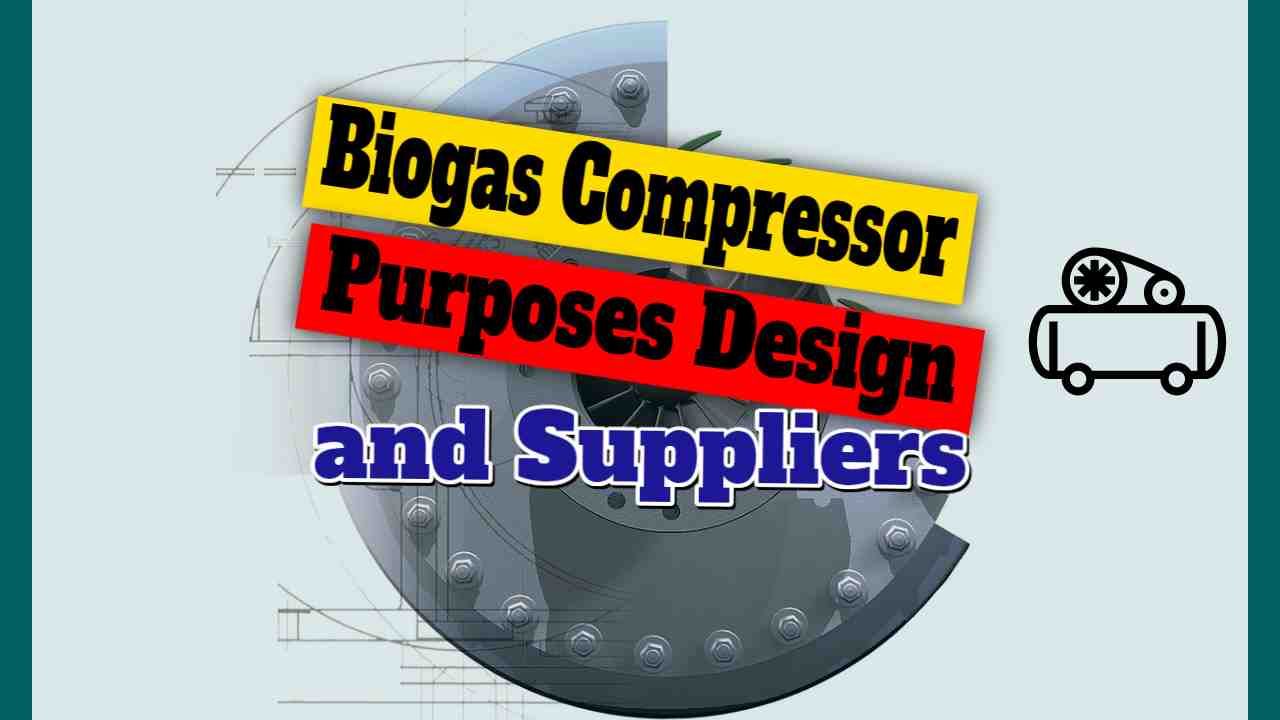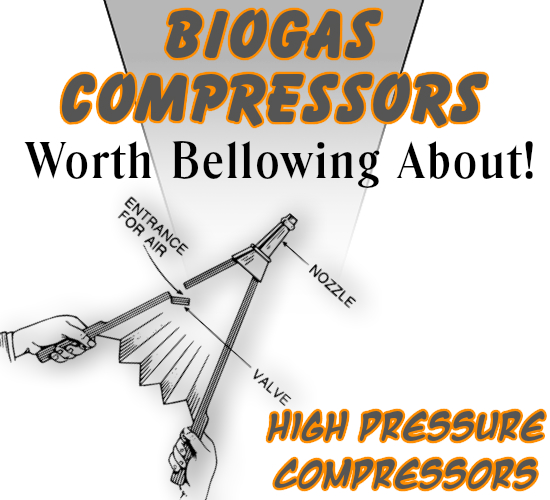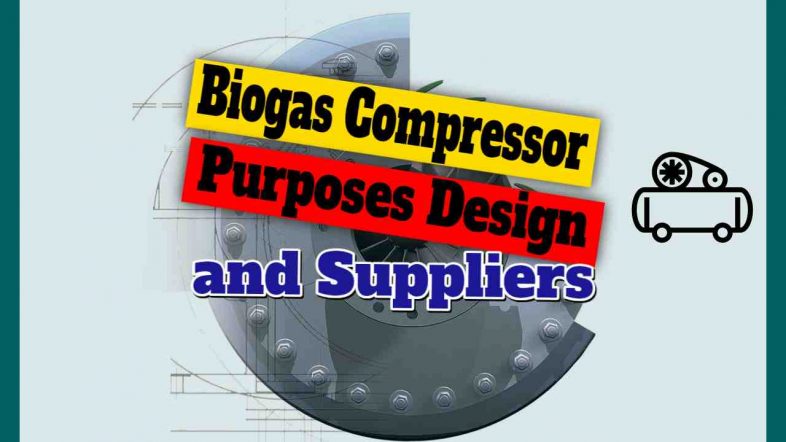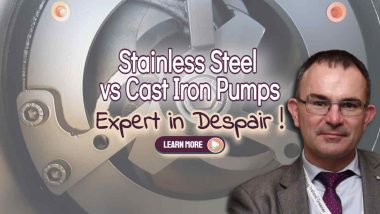We thought that we would write about the biogas compressor, its purposes. Plus, its design and suppliers of the equipment within an anaerobic digestion plant.
Harnessing the power of biogas is a sustainable and eco-friendly solution that addresses both energy needs and environmental concerns. At the heart of this process lies the biogas compressor. It is a critical component that ensures methane is purified, upgraded, and efficiently compressed for various applications.
Whether you're an industry professional or exploring renewable energy options, understanding the purposes, design, and available suppliers of biogas compressors is essential. Let's delve into the world of biogas compressors and discover how they can transform your energy solutions.
Compressors Designed for the Biogas Industry
The biogas compressor is a product that has only been available since early in the 2010s. However, their use and the technology behind biogas compression has been developing fast. The biogas compressor is an essential component of all biogas plants.
There is a growing market for the specialized corrosion resistant compressors required. The essential features sought in compressors for biogas treatment and handling are:
- safety,
- dependability, and
- low running costs
- easy to service.
Biogas Compression Trends
There is greater sophistication in the design of modern biogas plants, now that the many benefits from anaerobic digestion are becoming better understood globally.
Rather than generate electricity for supply into a local grid, there is far more value in the biogas if it is purified (upgraded) and compressed.
The market is huge for renewable cylinder gas. The result is that many installations will need more than one biogas compressor we decided to make a video, to present the subject.
A low-pressure compressor is used to convey the stored biogas to the upgrading equipment. After upgrading a high-pressure compressor is required to fill the cylinders.
We invite you to watch our video about these compressors below:

Understanding Biogas and the Need for Compression
Biogas is a renewable energy source produced through the anaerobic digestion of organic matter such as agricultural residues, animal manure, and food waste. Composed primarily of methane (CH₄) and carbon dioxide (CO₂), biogas holds immense potential as a sustainable fuel. However, to maximize its utility, biogas must undergo purification and compression.
Why Compression Matters:
- Purification: Raw biogas contains impurities like hydrogen sulfide (H₂S), moisture, and siloxanes that must be removed to prevent damage to equipment and ensure safe usage.
- Energy Density: Compressing biogas increases its energy density, making it suitable for applications such as electricity generation, heating, and as a fuel for vehicles.
- Storage and Transport: Compressed biogas can be efficiently stored and transported, facilitating its integration into existing energy infrastructures.
[Insert Diagram of Biogas Production and Compression Process]
Purification and Upgrading of Biogas
Before biogas can be effectively utilized, it needs to be purified and upgraded to remove contaminants and increase its methane concentration. This process ensures that the biogas meets the required standards for various applications.
Steps in Biogas Purification:
- Desulfurization: Removes hydrogen sulfide to prevent corrosion and protect equipment.
- Moisture Removal: Eliminates water vapor to avoid freezing in pipelines and compressors.
- Carbon Dioxide Removal: Increases methane concentration, enhancing the fuel's energy content.
- Filtration: Removes particulate matter and siloxanes that can damage engines and turbines.
Purpose of Biogas Compressors
Biogas compressors play a pivotal role in the purification and upgrading process. Their primary functions include:
- Pressure Regulation: Maintains optimal pressure levels required for efficient biogas utilization.
- Flow Control: Ensures a steady and controlled flow of biogas to downstream applications.
- Energy Optimization: Facilitates the efficient conversion of biogas into usable energy by enabling high-pressure storage and transport.
Key Purposes:
- Enhancing Safety: Proper compression minimizes the risks associated with high-pressure gas systems.
- Improving Efficiency: Compressed biogas can be used more effectively in generators, engines, and fuel cells.
- Facilitating Versatility: Enables biogas to be used in a wider range of applications, from small-scale generators to large industrial systems.
Design Considerations for Biogas Compressors
Designing an effective biogas compressor involves several critical considerations to ensure reliability, efficiency, and longevity.

Essential Biogas Compressor Design Factors:
1. Material Selection:
- In the demanding presence of biogas and the many compressors that compress the raw biogas or less than completely upgraded biogas the following material selection guide has an added importance:
Corrosion Resistance:
- Components must withstand corrosive substances like hydrogen sulfide.
Durability:
- Materials should be able to endure the operational pressures and environmental conditions.
2. Compression Stages:
- Biogas compressors vary in the number of compression stages used to achieve the required compressive force.
Single-Stage vs. Multi-Stage:
Multi-stage compressors offer better efficiency and higher pressure capabilities.
3. Sealing Mechanisms:
- Reliable seals are essential to prevent gas leaks and ensure system integrity.
4. Energy Efficiency:
- Designs should minimize energy use while maximizing compression output.
5. Heat Management:
- Effective cooling systems prevent overheating and enhance performance.
6. Maintenance Accessibility:
- Designs should allow for easy access to components for routine inspections and repairs.

“Multistage Compression – an overview …” from www.sciencedirect.com and used with no modifications.
Types of Biogas Compressors
Biogas compressors come in various types, each suited to specific applications and operational requirements.
1. Reciprocating Compressors

“Reciprocating Compressors Introduction …” from www.pipingengineer.org and used with no modifications.
Features:
- Utilize pistons driven by a crankshaft to compress gas.
- Ideal for high-pressure applications.
- Suitable for smaller biogas plants due to their compact size.
Advantages:
- High efficiency at variable loads.
- Reliable and proven technology.
Applications:
- Small to medium-sized biogas facilities.
- Scenarios requiring intermittent operation.
2. Rotary Screw Compressors

“Rotary Screw Air Compressor: What are …” from www.youtube.com and used with no modifications.
Features:
- Use two meshing helical screws to compress gas.
- Known for continuous operation capabilities.
- Suitable for larger biogas plants with high gas flow requirements.
Advantages:
- Low maintenance needs.
- Smooth and quiet operation.
Applications:
- Large-scale biogas production.
- Industries requiring a continuous supply of compressed biogas.
3. Centrifugal Compressors

“Centrifugal Air Compressors: How Do …” from blog.exair.com and used with no modifications.
Features:
- Employ a rotating impeller to add velocity to the gas, converting it to pressure.
- Best suited for very high flow rates and pressures.
- Typically used in industrial settings.
Advantages:
- Extremely efficient for large volumes.
- Compact design for high-capacity compression.
Applications:
- Industrial biogas facilities.
- Applications demanding high-pressure gas.
4. Diaphragm Compressors

“Diaphragm Compressors” from sollantcompressor.com and used with no modifications.
Features:
- Use a flexible diaphragm to compress gas without direct contact with moving parts.
- Ideal for handling corrosive or abrasive gases.
Advantages:
- Leak-proof operation.
- Minimal maintenance.
Applications:
- Biogas facilities with high levels of contaminants.
- Situations requiring clean gas compression.

“Compressors Used …” from www.linkedin.com and used with no modifications.
Selecting the Right Supplier for a Biogas Compressor
Choosing the right supplier for your biogas compressor is crucial for ensuring the success and efficiency of your biogas operations. Here are key factors to consider:
1. Expertise and Experience
- Industry Knowledge: Suppliers with a deep understanding of biogas technologies and market trends.
- Track Record: Proven history of successful installations and satisfied clients.
2. Product Range and Quality
- Variety: A wide range of compressor types and models to match diverse requirements.
- Quality Assurance: Adherence to international standards and certifications.
3. Customization and Flexibility
- Tailored Solutions: Ability to customize compressors based on specific project needs.
- Scalability: Solutions that can grow with your biogas production capacity.
4. After-Sales Support
- Maintenance Services: Availability of maintenance contracts and support.
- Technical Assistance: Responsive technical support for troubleshooting and upgrades.
5. Cost-Effectiveness
- Competitive Pricing: Balancing cost with quality and performance.
- Total Cost of Ownership: Considering long-term maintenance and operational costs.
Table Comparing the Leading US Biogas Compressor Suppliers
Here is a comparison of leading U.S. biogas compressor suppliers and the types of biogas compressors they offer:
| Supplier | Compressor Types | Notable Features |
|---|---|---|
| LeROI (Gardner Denver) | – Oil-flooded rotary screw compressors- Reciprocating compressors | Designed to handle raw, water-saturated biogas with high levels of H₂S and CO₂. Applications include vapor and flare recovery, landfill and biogas management, and fuel system enhancement. Power capacities up to 900 hp. |
| BAUER Compressors | – Rotary screw compressors | Pre-engineered biogas compressors ranging from 15 to 350 hp, with inlet pressures from 0.1 to 35 psig and flow rates between 10 to 1,728 scfm. Options include gas inlet particulate filters, gas aftercoolers, and sound attenuation. |
| AERZEN | – Oil-injected screw compressors | Customized solutions for biogas treatment and injection, conforming to ATEX and DVGW regulations. Models like VMY, VMX, and Series C cater to various pressure and flow requirements. |
| Wittig (Ingersoll Rand) | – Rotary vane compressors (RO-G, L-GK, RVA-G series) | Designed for biogas applications, offering air-cooled and water-cooled options. Capacities range from 119 to 5,262 m³/h with operating pressures up to 17 bar. Features include compact design, minimal maintenance, and suitability for handling dirty gases. |
| Chicago Pneumatic | – Oil-lubricated screw compressors- Low-pressure reciprocating compressors | Specifically designed to handle the corrosive nature of biogas and impurities like moisture and hydrogen sulfide. Features include robust materials, advanced sealing technologies, and options for acoustic enclosures. |
| Mattei Group | – Rotary vane compressors (RVG/RVGC series) | Compressors for natural gas, technical gas, and biogas treatment. Emphasis on safety, reliability, and low operating costs. Compliance with ATEX regulations and designed for continuous 24/7 operation. |
| Elliott Company | – Multi-stage centrifugal compressors | Designs and manufactures compressors for various gases, including biogas. Offers six different compressor types (M-line, MB-line, MBP-line, P-line, PH-line, A-line) to meet varying flow rates and pressure capacities. |
| Adicomp S.p.A. | – Oil-injected rotary screw compressors (UVG series) | Compression and treatment systems for biogas, offering capacities up to 2,000 m³/h and pressures up to 25 bar. Designed for efficiency and reliability in biogas applications. |
| Fornovo Gas SpA | – Piston compressors | Offers a range of compressors suitable for biogas applications, focusing on performance and adaptability to various operational conditions. |
| Applied Compression Systems | – Customized compressor and blower packages | Provides tailored solutions for biogas compression, including low, medium, and high-pressure systems designed to meet specific project requirements. |
This table provides an overview of the primary compressor types and notable features offered by leading U.S. biogas compressor suppliers. For detailed specifications and to determine the best fit for specific applications, it's recommended to consult directly with the manufacturers.
Benefits of Choosing Specialist Biogas Compressors
Opting for compressors specifically designed for biogas offers numerous advantages over generic solutions.
Key Benefits:
- Enhanced Performance: Tailored to handle the unique properties of biogas, ensuring optimal efficiency.
- Increased Longevity: Built with materials and designs that withstand biogas impurities, reducing wear and tear.
- Improved Safety: Incorporates safety features that address the specific risks associated with biogas compression.
- Energy Savings: More efficient operation leads to lower energy consumption and reduced operational costs.
Real-World Impact:
By selecting specialist biogas compressors, facilities can achieve higher reliability, better performance metrics, and a smoother integration into their existing energy systems, ultimately contributing to a more sustainable energy landscape.
[Insert Case Study Highlighting a Successful Compressor Installation]
Applications of Compressed Biogas
Compressed biogas, often referred to as biomethane, is a versatile energy carrier with a wide range of applications across various sectors.
1. Power Generation
- Electricity Production: Compressed biogas can fuel generators to produce electricity, supporting both on-grid and off-grid power needs.
- Cogeneration Systems: Simultaneous production of electricity and heat, enhancing overall energy efficiency.
2. Transportation Fuel
- Compressed Natural Gas (CNG) Vehicles: Biogas can be upgraded to biomethane and used as a clean alternative to fossil fuels in vehicles.
- Public Transport: Buses and other public transportation vehicles can run on compressed biogas, reducing emissions and fossil fuel dependency.
3. Heating Applications
- Industrial Heating: Biogas can be used in boilers and furnaces for various industrial processes.
- Residential Use: In some regions, biomethane is integrated into the natural gas grid for heating and cooking.
4. Industrial Processes
- Chemical Production: Biomethane serves as a feedstock for producing chemicals and materials.
- Food and Beverage Industry: Utilized in processes requiring consistent and reliable energy sources.
5. Grid Injection
- Supplementing Natural Gas: Upgraded biogas can be injected into the natural gas grid, supporting renewable energy targets and reducing greenhouse gas emissions.
- Energy Storage: Acts as a storage medium for excess renewable energy, balancing supply and demand.

“Compressed Biogas Guide – Selling, Regs …” from blog.anaerobic-digestion.com and used with no modifications.
Advantages of Biogas Compression Over Other Renewable Energy Sources
While there are numerous renewable energy sources available, biogas compression offers unique advantages that make it a compelling choice for many applications.
1. Baseload Power Availability
Unlike solar and wind energy, which are intermittent, biogas provides a consistent and controllable energy supply, making it ideal for baseload power.
2. Waste Management Synergy
Biogas production simultaneously addresses waste management issues by converting organic waste into valuable energy, promoting a circular economy.
3. Carbon Neutrality
Biogas is considered carbon-neutral since the carbon dioxide released during its combustion is offset by the carbon dioxide absorbed during the growth of the organic matter used to produce it.
4. Versatility in Usage
Compressed biogas can be used across various sectors, offering flexibility in applications from transportation to industrial processes.
5. Local Energy Production
Biogas facilities can be established locally, reducing dependence on imported energy and enhancing energy security for communities and industries.
Environmental Impact and Sustainability
Embracing biogas compressors not only supports energy needs but also contributes significantly to environmental sustainability.
Key Environmental Benefits:
- Reduction in Greenhouse Gas Emissions: Captures methane, a potent greenhouse gas, preventing its release into the atmosphere.
- Renewable Resource Utilization: Makes use of organic waste materials, promoting resource recycling and reducing landfill usage.
- Energy Efficiency: Enhances the overall efficiency of renewable energy systems, leading to lower environmental footprints.
Long-Term Sustainability:
Investing in biogas compressors is a step towards a sustainable energy future, aligning with global efforts to combat climate change and promote renewable energy solutions.

How to Choose the Right Biogas Compressor for Your Needs
Selecting the appropriate biogas compressor involves a careful assessment of your specific requirements and understanding the various options available.
Steps to Choose the Right Compressor:
1. Assess Biogas Composition:
- – Determine the levels of methane, carbon dioxide, and impurities in your biogas to select a suitable compressor type.
2. Determine Required Pressure and Flow Rate:
- – Assess your application's pressure and flow rate needs to ensure the compressor can meet these demands efficiently.
3. Evaluate Energy Efficiency:
- – Consider compressors with high energy efficiency to reduce operational costs and environmental impact.
4. Check for Compliance and Certifications:
- – Ensure the compressor meets relevant industry standards and certifications for safety and performance (EU ATEX Directives).
5. Consider Scalability:
- – Choose a compressor that can scale with your biogas production as your needs grow over time.
6. Review Supplier Support and Services:
- – Opt for suppliers that offer comprehensive support, including installation, maintenance, and technical assistance.
[Coming Soon: A Checklist for Selecting a Biogas Compressor]
The Future of Biogas Compression Technology
As the demand for renewable energy continues to rise, biogas compression technology is evolving to meet these needs more effectively. Innovations focus on enhancing efficiency, reducing costs, and integrating smart technologies for better control and monitoring.
Emerging Trends:
- Smart Compressors: Incorporation of IoT and automation for real-time monitoring and optimization.
- Energy Recovery Systems: Utilizing waste heat from compression processes to improve overall system efficiency.
- Modular Designs: Facilitating easier installation, scalability, and maintenance.
Anticipated Developments:
- Advanced Materials: Development of new materials to increase durability and resistance to biogas impurities.
- Hybrid Systems: Combining different compression technologies to achieve higher efficiency and flexibility.
- Sustainable Manufacturing: Emphasis on eco-friendly manufacturing processes and materials for compressors.

Getting Started with Your Biogas Compression Solution
Embarking on a biogas compression project can seem daunting, but with the right guidance and support, it becomes a manageable and rewarding endeavor. Here's how to take the first steps towards implementing an effective biogas compression system.
Steps to Initiate Your Biogas Compression Project:
- Conduct a Feasibility Study:
- – Evaluate the potential of biogas production and compression within your specific context.
- Consult with Experts:
- – Engage with knowledgeable suppliers and engineers to understand the best solutions for your needs.
- Design Your System:
- – Collaborate with suppliers to design a biogas compression system tailored to your requirements.
- Secure Funding and Approvals:
- – Explore funding options and obtain necessary permits and regulatory approvals.
- Install and Commission:
- – Work with your supplier to install the compressor and ensure it operates correctly through thorough commissioning.
- Ongoing Maintenance and Optimization:
- – Implement a maintenance schedule and continuously monitor performance to optimize efficiency.
[Original article uploaded 31 Jan 2016. Updated September 2021. Latest update March 2025.]






You write that biomethane is a great replacement fuel for compressed natural gas, but that it needs to be compressed to a higher pressure for equivalent calorfic value. Does this mean biomethane is less energy dense? Thanks.
Yes. That is correct. In the UK when biomethane is injected into the natural gas grid,it has to have an additional fuel added to raise the calorific value, because higher compression is not possible. The fuel added is propane, but of course this has a negative effect on the green credentials of biomethane.
Yes.
Good writing. This is high quality blog. Offering you a complete choice of products which include biogas compressor and bio gas compressor.
Your blog is very informative. Here you talk about the Biogas Compressor Purposes, Design and Suppliers. This blog is very helpful for manufacturer.
Thanks for sharing this information.
Kudos for this article. Very helpful
Hi, is there any risk of explosion using those types of compressor? They have a piston right? For example if you forget to change or add new oil, is it a risk? Or does the absence of oxygen minimize it?